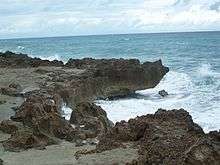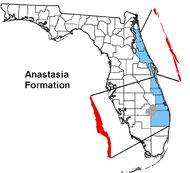Anastasia Formation
| Anastasia Formation Stratigraphic range: Late Pleistocene | |
|---|---|
 Part of the formation on Hutchinson Island | |
| Type | Geological formation |
| Lithology | |
| Primary | Coquina, sand, sandy limestone |
| Other | Sandy marl |
| Location | |
| Region | South Florida |
| Country |
|
| Extent | St. Johns—Palm Beach County |
| Type section | |
| Named for | Anastasia Island |
| Named by | E. H. Sellards, 1912 |

The Anastasia Formation is a geologic formation deposited in Florida during the Late Pleistocene epoch.
Age
Period : Quaternary
Epoch: Pleistocene ~2.558 to 0.012 mya, calculates to a period of 2.576 million years
Faunal stage: Blancan through early Rancholabrean
Location
Anastasia Formation overlays The Atlantic Coastal Ridge along the coast from St. John's County southward to Palm Beach County and extends inland as far as 20 miles (32 kilometers) in St. Lucie and Martin County. Blowing Rocks Preserve in northern Palm Beach County is an exposed outcropping along the beach.[1][2]
Composition
The Anastasia Formation, named by E. H. Sellards in 1912, is composed of interbedded sands and coquina limestones. The formation is an orangish brown, soft to moderately hard, coquina of whole and fragmented mollusk shells within sand often cemented by sparry calcite.[3][4] Coquina obtained from this formation on Anastasia Island was used to construct Castillo de San Marcos during the late 17th century; a local material, it was relatively easy to quarry and proved to be effective for absorbing cannon damage.[5] Sands occur as fossil bearing light gray to tan as well as orangish brown, unconsolidated to moderately indurated. This formation is an integral part of the surficial aquifer system.[3][4]
References
- ↑ The Nature Conservancy, Florida Preserves, Blowing Rocks
- ↑ http://sofia.usgs.gov/publications/reports/mgs_lovejoy1998/ USGS Publications, Classic Exposures of the Anastasia Formation in Martin and Palm Beach Counties, Florida.
- 1 2 USGS Publications, Lithostratigraphic Units, Tertiary System, Pleistocene Series
- 1 2 Classic Exposures of the Anastasia Formation in Martin and Palm Beach Counties, Florida, Donald W. Lovejoy
- ↑ Kenworthy, J. P.; Santucci, V. L. (2006). "A preliminary investigation of National Park Service paleontological resources in cultural resource contexts, Part 1: general overview". In Lucas, S. G.; Spielmann, J. A.; Hester, P.M.; Kenworthy, J. P.; Santucci, V. L. America’s antiquities: 100 years of managing fossils on federal lands (pdf). New Mexico Museum of Natural History and Science Bulletin. 34. Albuquerque, NM: New Mexico Museum of Natural History and Science. pp. 70–76.